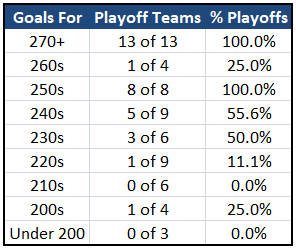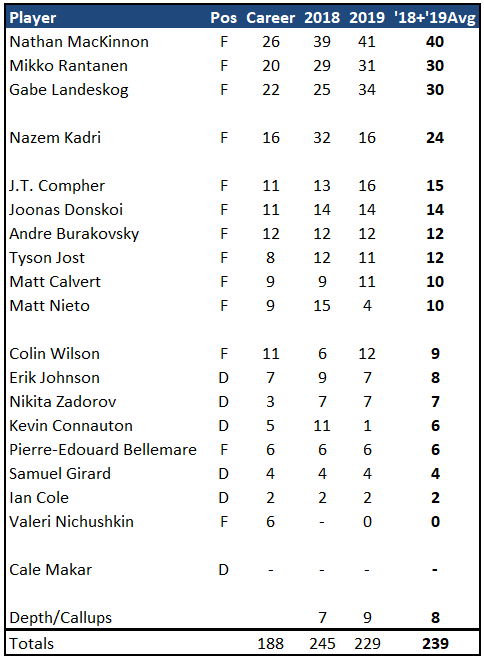© 2026 ALLCITY Network Inc.
All rights reserved.

It’s that time of year again. Preseason is winding down, rosters are finalizing, and the promise of a new season awaits.
For the Avs, that season comes with heightened expectations. Not only have they made the playoffs in consecutive years, but they easily blew through the top Western Conference team last April and pushed a very strong Sharks team to a dramatic Game 7. No longer are they an afterthought – even people out east are starting to pay attention to what could be a superpower rising in the post-bedtime west.
Living up to those expectations now starts with making the postseason. And for this up-tempo club, that starts with scoring goals.
How many will it take for them to make the playoffs? And how do they get there? While we won’t know for sure until next April, it’s worth taking a look at some trends and blocking out a road map to see how they can realistically reach that target.
Punching the Ticket
So, how many goals does it take to make the playoffs?
Last year, I made the argument that 240 is probably enough. However, at that point, we didn’t know that the jump in scoring we saw in 2017-18 was going to stick around. It seemed like an outlier, a fluke.
Well, the results of 2018-19 proved that it wasn’t. Scoring jumped again, going from a team average of 240 goals to 244. For reference, the team average hovered around 220 goals from 2014-17.
With that in mind, let’s look at who made the playoffs in the past two seasons.

The 240s are not the sure bet they used to be. Heading into last season, 80% of teams who hit that mark from 2014-18 made the postseason. But if you look at the past two years, it’s only around a 50/50 chance.
In the new NHL, 250 seems to be the magic cutoff. Yes, there’s some weirdness happening in the 260s, but that serves as a reminder that goals against matter too. If the Avs can manage that many tallies without allowing 273, 293, or 296 (!) goals against like the ’19 Panthers, ’19 Blackhawks, and ’18 Islanders (respectively), they should be fine.
The Breakdown
If the mark is 250, the good news is that the Avs don’t need a huge jump to meet it. In ’17-18, they scored 257 goals. In ’18-19, they scored 258. The rosters were similar, the production was similar, and both teams managed a similar wild card spot. For this roster to make the post-season, they just need to do it again.
However, there’s been significant turnover this summer. Barrie, Kerfoot, and Soderberg were big parts of the offensive equation last year, and they’ve all been replaced with new faces. The Avs are looking at potentially adding multiple rookies this year as well, especially on defense.
Since scoring is up in the past two seasons, it makes sense to take a look at how each of the players has performed over that time to get a sense of what they might accomplish this year. Career averages are included for reference as well.
239 is certainly a respectable number for an off-the-cuff projection, but it falls 11 short of the 250 mark. So how might the Avs find those extra goals?
The biggest add will be from Cale Makar. He’s already scored one goal in 10 playoff games, and we know he’ll receive top-four minutes and take over Tyson Barrie‘s spot as the quarterback on the top power play unit. 11 goals as a rookie defenseman is a big ask, but with his talent and opportunity, it’s not an unreasonable one.
Nazem Kadri should also slot in above his projection. Last season was an odd one for him, as the arrival of John Tavares in Toronto pushed him down onto the third line. He’d scored 32 goals in each of his previous two seasons as the Maple Leafs’ second line center, so there’s a very good chance he’ll clock in back around that mark with the Avs.
From there, some players will have career years, while others will have seasons marred by injury or bad luck. Depending on how the roster shakes out, Donskoi and Burakovsky may see more ice time and responsibility than they did with their old clubs. Nieto and Compher were part of the de facto second line last year and may see their production decrease as they’re slotted further down the lineup. Young players like Jost or Girard could take a step forward offensively. Gabe Landeskog could see his numbers come down after a high goal season.
Either way, as long as the Avs top players stay healthy, the rest of the roster should be able to even out the scoring among themselves. Hitting the 250 or even 260 goal mark is a reasonable expectation for this team.
In short, you better get your goal song “HEY HEY HEY”s in order, Avs fans, because at least on paper this season is shaping up to be a fun ride well into April and possibly beyond.
Comments
Share your thoughts
Join the conversation





